Can Content Personalization Increase Engagement by 150%?

What’s Inside
- What Is Content Personalization?
- What Are the Examples of Content Personalization?
- How Does the Personalization of Content Work?
- What Are the Advantages of Personalized Content for e-stores & Customers?
- What Are the Smart Ways to Execute Content Personalization Successfully?
- What Are the Challenges in Adopting Personalization in Content?
- Here’s Experro’s Formula for Content Personalization!
- Conclusion
Key Takeaways
- Content personalization boosts engagement and conversions by using AI-driven recommendations to deliver tailored experiences based on user behavior.
- Leveraging automation and AI-driven insights helps scale personalization without complexity.
- Overcoming barriers to personalization of content, like data privacy and scalability, is key to unlocking the full potential of personalization.
- Experro’s AI-powered personalization ensures seamless, data-driven experiences across all customer touchpoints.
Did you know personalized content can boost engagement by 80%? It’s not just about products—users connect with brand content too.
Yet, many businesses still rely on generic content that fails to capture user interest.
AI-powered content personalization isn’t just a trend—it’s the key to delivering relevant, engaging experiences that drive conversions.
By leveraging AI, behavioral insights, and real-time customer data, businesses can tailor content to individual preferences, making every interaction more meaningful.
But how does B2B content personalization work, and what makes it so effective?
Let’s explore!
What Is Content Personalization?
Content personalization meaning - It is to tailor digital content to individual users based on their preferences, behavior, and demographic data.
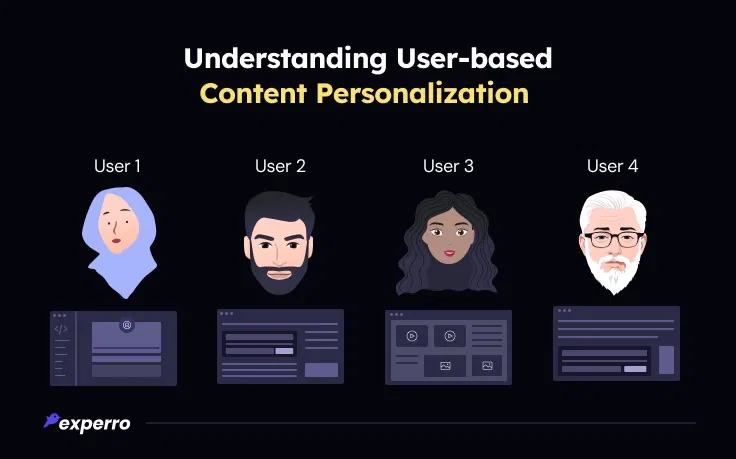
It ensures that the target audience receives relevant targeted promotions and customized experiences.
This is done by analyzing past interactions, purchase history, and real-time data. Your business uses personalization to create seamless, engaging, and conversion-friendly experiences.
This approach goes beyond generic experiences, making interactions more relevant and engaging for users.
In the next section are some examples of how personalization of content works in action.
What Are the Examples of Content Personalization?
Personalization of content tailors digital experiences based on user behavior, preferences, and past interactions. It helps businesses create more relevant and engaging experiences for their audience.
Here are some examples:
- Personalized homepage experience – Showing content based on user preferences and past visits.
- Customized video recommendations – Suggesting videos based on watch history.
- Email marketing personalization – Sending tailored emails with relevant products and offers.
- Behavior-based push notifications – Alerting users about deals based on their activity.
- AI-powered chatbots – Providing instant, personalized responses and suggestions.
How Does the Personalization of Content Work?
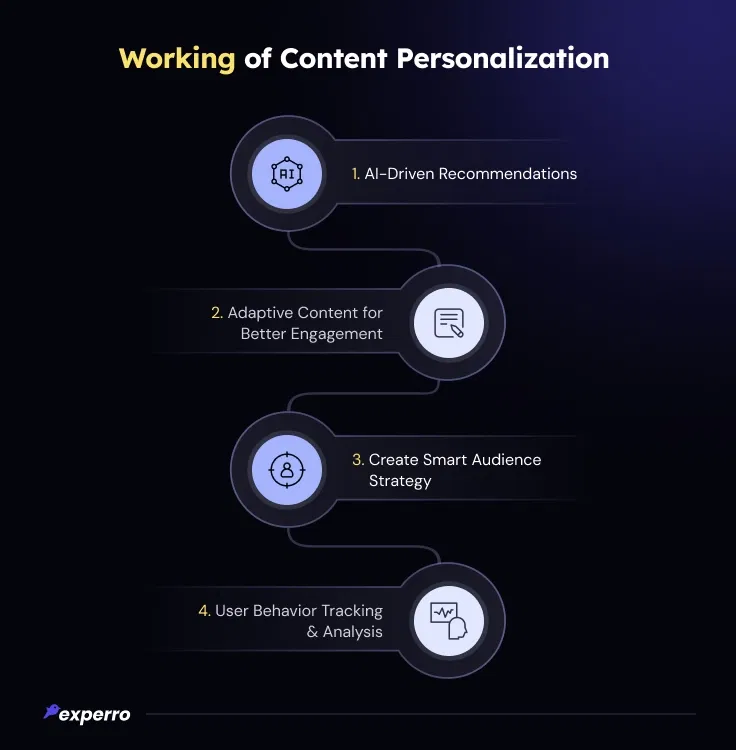
Personalization of website content leverages data, artificial intelligence (AI), and behavioral insights to deliver tailored, user-specific experiences.
Here's how it works:
1. Understanding Users with Analytics
Content personalization algorithms start with tracking eCommerce analytics like user behavior—clicks, dwell time, abandoned carts, and browsing history. These insights help businesses understand user intent and preferences, forming the foundation for personalized experiences.
2. Creating a Smart Audience Strategy
Once user data is collected, AI and eCommerce analytics segment audiences based on demographics, purchase history, and interests. This segmentation allows businesses to deliver highly targeted content to the right users at the right time.
3. AI-Driven Recommendations
AI-powered algorithms analyze search patterns and past interactions to predict what users are likely to engage with next. Whether it's product suggestions, blog recommendations, or personalized promotions, content evolves dynamically based on user activity.
4. Dynamic Content Adaptation
Websites and digital platforms adjust in real-time by changing headlines, images, and personalized webpage sections based on user data. This ensures each visitor sees content relevant to their behavior, location, and device—enhancing engagement and driving conversions.
According to the content personalization statistics, 78% of U.S. internet users say personally relevant content increases their purchase intent.
What Are the Advantages of Personalized Content for e-stores & Customers?
Personalized content drives engagement, boosts conversions, and builds long-term customer relationships.
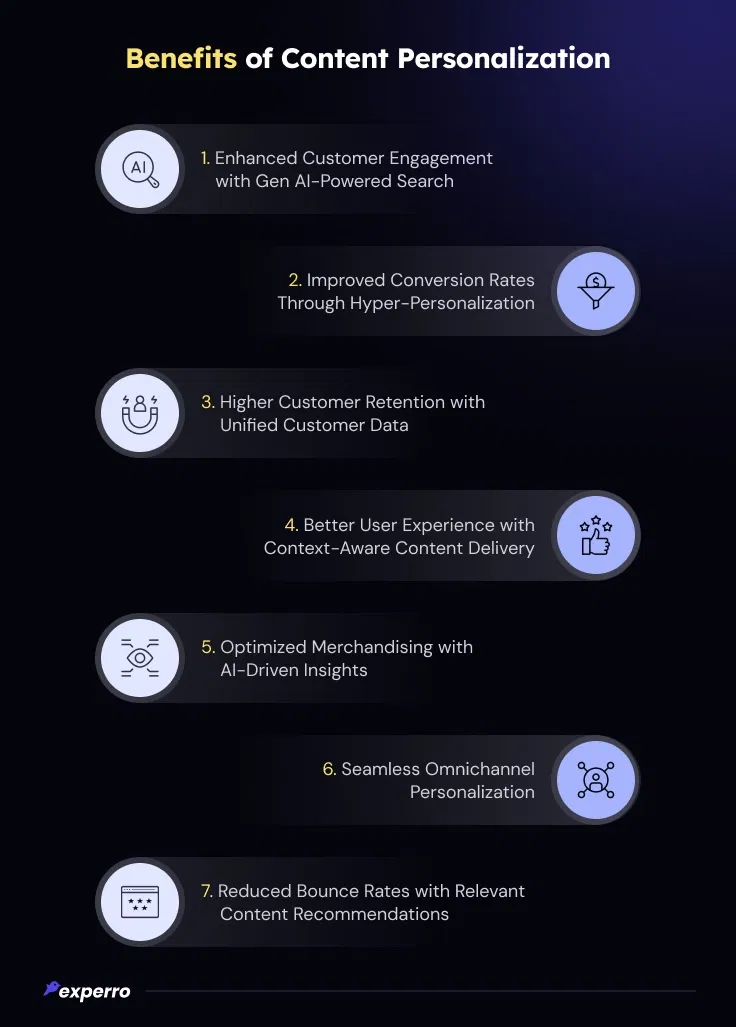
Let’s explore its key benefits:
1. Enhanced Customer Engagement with Gen AI-Powered Search
Gen AI-driven search engines analyze user behavior to deliver highly relevant search results. Instead of generic listings, customers see products and content that match their intent.
This personalized experience encourages deeper exploration, leading to higher engagement.
2. Improved Conversion Rates Through Hyper-Personalization
When users see products or content tailored to their interests, they are more likely to take action.
Hyper-personalization, powered by real-time behavioral data and predictive analytics, refines product recommendations, leading to higher sales and lower cart abandonment rates. The result is a seamless shopping journey that drives more purchases.
3. Higher Customer Retention with Unified Customer Data
By integrating customer data from multiple touchpoints—website visits, past purchases, and engagement history—businesses create a unified profile for each user.
This ensures consistency in overall types of website personalization across different interactions, fostering long-term customer loyalty. A well-rounded customer profile enables brands to anticipate needs and offer timely, relevant interactions.
4. Better User Experience with Context-Aware Content Delivery
Users expect experiences tailored to their context and preferences. Context-aware personalization tailors content delivery based on factors like device type, location, and browsing history.
Whether a user is shopping on mobile or desktop, they receive a seamless and intuitive experience. This responsiveness minimizes friction and enhances overall customer satisfaction.
5. Optimized Merchandising with AI-Driven Insights
AI analyzes purchasing trends, demand fluctuations, and user preferences to optimize product placement and promotions.
Retailers can highlight bestsellers in featured products section, showcase complementary products, and adjust pricing dynamically, maximizing sales opportunities. Data-driven digital merchandising ensures businesses stay ahead of changing customer demands.
6. Seamless Omnichannel Personalization
Customers interact with brands across multiple channels—websites, apps, emails, and social media.
An omnichannel personalized strategy ensures that their experience remains consistent and relevant across all touchpoints, improving engagement and satisfaction. This continuity strengthens brand relationships and encourages repeat visits.
7. Reduced Bounce Rates with Relevant Content Recommendations
When users land on a website and immediately find content that matches their interests, they are more likely to stay.
Generative AI for content personalization and recommendations keeps visitors engaged, guiding them toward relevant pages and improving the conversion rate optimization. A well-structured recommendation system turns passive browsing into active engagement.
To leverage these benefits, your business needs the right content personalization strategies—let’s explore them.
What Are the Smart Ways to Execute Content Personalization Successfully?
Implementation of content personalization requires a data-driven approach backed by AI and automation.
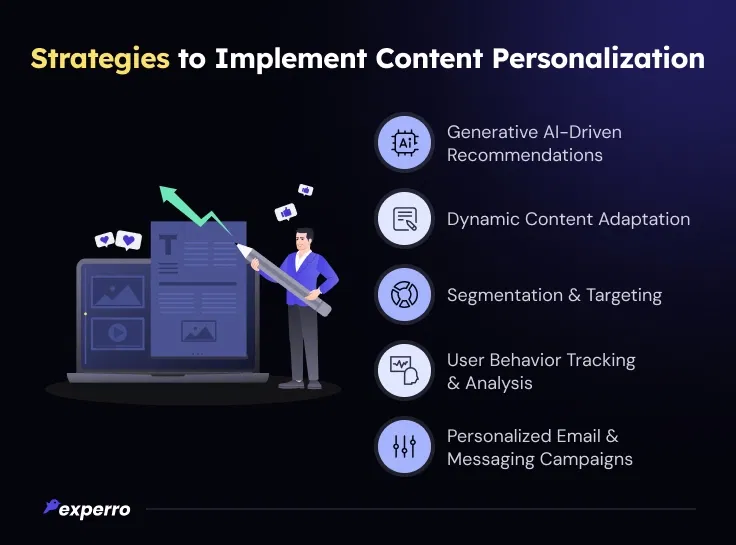
Here is the content personalization approach to make it work:
1. Gen AI-Driven Recommendations
Use AI models for content personalization to analyze user data and generate precise recommendations.
By learning from user behavior, AI can predict future preferences and deliver personalized product suggestions, making product discovery faster and improving shopping experiences.
2. Adaptive Content for Better Engagement
Implement real-time adaptive content that responds to user interactions. If a customer frequently browses, specific product attributes dynamically adjust the personalized homepage, landing page, menus, and CTAs to highlight relevant products.
This creates personalized content experience, reducing friction in the entire customer journey.
3. Segmentation and Targeting
You can gain insights into user intent by monitoring clicks, session duration, and cart activity. Use tailored promotions and product suggestions for each segment to boost engagement and drive conversions.
Effective segmentation helps brands deliver hyper-relevant content, driving higher conversion rates.
4. User Behavior Tracking and Analysis
Track clicks, session duration, and cart activity to identify user intent. Leverage these insights to fine-tune your personalization capability, ensuring content resonates with customers at every stage of their journey.
These insights help refine gen AI for personalization strategies, ensuring content aligns with customer needs at different stages of their journey. Real-time tracking allows businesses to adapt their approach instantly for better results.
5. Personalized Email and Messaging Campaigns
Automated content personalization tools send customized emails and messages. Whether it's a product restock alert, exclusive discount, or content recommendation, these marketing campaigns can help you boost engagement and customer retention.
Timely and relevant communication fosters brand loyalty and repeat purchases.
However, while personalized content enhances user experiences and boosts engagement, implementing it effectively comes with its own set of challenges.
Let’s explore them.
What Are the Challenges in Adopting Personalization in Content?
Despite its advantages, real-time content personalization methods come with challenges.
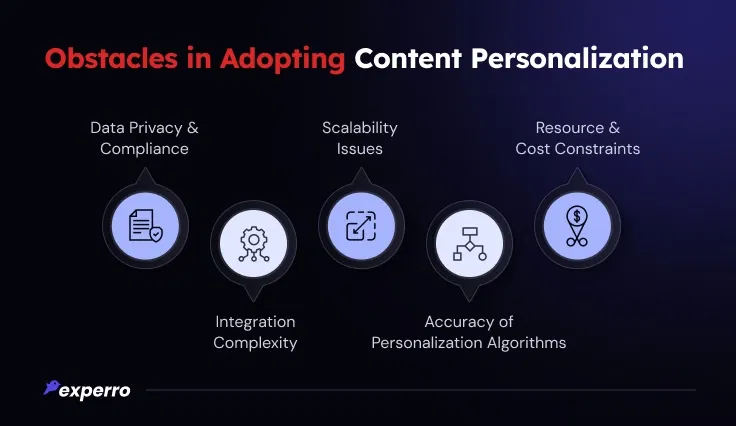
Your e-stores must address the following barriers to content personalization to unlock their full potential:
1. Data Privacy and Compliance
Personalization relies on user data, making privacy a major concern. Your business must comply with regulations like GDPR and CCPA, ensuring transparency in data collection and usage while maintaining customer trust.
To address this, Experro ensures consent management, compliant consumer data handling while enabling personalized experiences without compromising privacy.
2. Integration Complexity
Implementing personalization requires seamless integration with existing systems, such as CMS, CRM, and analytics. A fragmented tech stack can hinder data flow, making it difficult to deliver consistent experiences.
However, Experro’s unified DXP eliminates integration challenges by offering built-in AI-powered search, headless CMS architecture, and personalization in a single platform.
3. Scalability Issues
As your business grows, strategies for personalization of content must scale accordingly. Handling large datasets and delivering real-time personalized customer experiences to millions of users requires robust infrastructure and AI-driven automation.
To overcome this, Experro’s scalable and content personalization architecture ensures seamless AI-driven content personalization at a scale, even as businesses expand.
4. Accuracy of Personalization Algorithms
Personalization is only effective if the recommendations are relevant. Poorly trained algorithms or insufficient data can lead to irrelevant content suggestions, diminishing the user experience rather than enhancing it.
To solve this, Experro’s AI-powered personalization process refines recommendations based on real-time data, ensuring precision and search relevance.
5. Resource and Cost Constraints
Implementing AI-driven personalization requires investment in technology, talent, and infrastructure. Smaller businesses may struggle with the upfront costs and ongoing maintenance, so balancing costs with expected ROI is crucial.
To make this easier, Experro’s all-in-one platform reduces the need for multiple software personalize the content, optimizing costs while delivering enterprise-level personalization.
Here’s Experro’s Formula for Content Personalization!
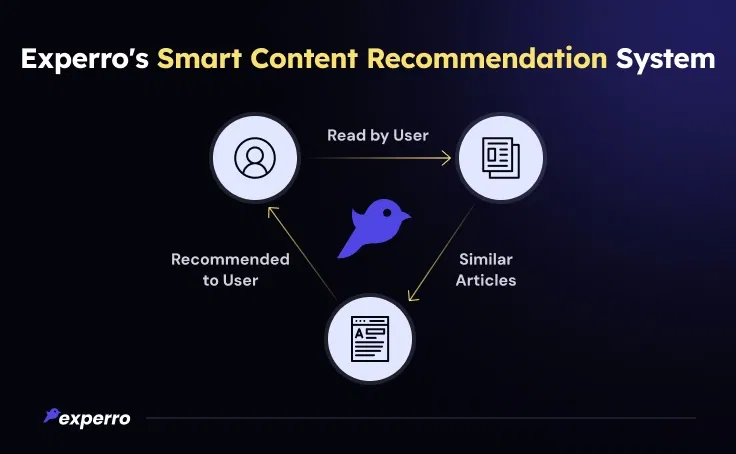
Experro empowers businesses with AI-driven personalization tools, helping them deliver tailored experiences at scale.
Here’s how:
- AI-Powered Search: Experro’s AI-driven search understands user intent, refines queries, and delivers highly relevant results to enhance the shopping experience.
- Dynamic Content Personalization: Businesses can personalize website content, layouts, product displays, and messaging in real-time based on customer behavior.
- Omnichannel Consistency: Experro ensures a seamless experience across web, mobile, and social platforms, enhancing customer engagement.
- AI-Powered Recommendations: Using behavioral insights and real-time data, Experro provides personalized AI-based product recommendations that drive engagement and conversions.
- Scalable Content Personalization Engine: Our platform integrates with existing systems, making personalization effortless without adding complexity.
With content personalization platforms like Experro, businesses can turn data into actionable insights, driving better engagement, conversions, and customer loyalty.
Conclusion
Content customization is essential for creating meaningful digital experiences. From AI-driven recommendations to dynamic content adaptation, businesses that embrace personalization see higher engagement, better retention, and increased sales.
With a robust solution like Experro, businesses can unlock the true potential of personalization and stay ahead in the competitive eCommerce landscape.
Schedule a call with our experts today to explore how Experro can elevate your personalization and marketing strategy.
FAQs


Pallavi Dadhich
07 March 2025Pallavi is an ambitious author known for her expertise in crafting compelling content across various domains. Beyond her professional pursuits, Pallavi is deeply passionate about continuous learning, often immersing herself in the latest industry trends. When not weaving words, she dedicates her time to mastering graphic design.